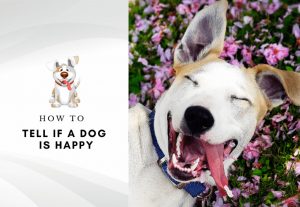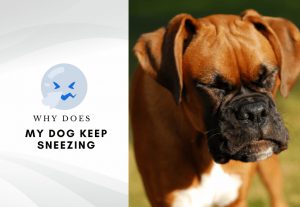In this blog post, You will learn how to tell if your female dog is in heat. From changes in behavior to physical signs, we’ll cover everything you need to know to keep your pup happy and healthy during this natural process.
If you own a female dog that has not been spayed, it’s important to know what to expect and the signs of a dog in heat. This can help you prepare for the experience and avoid unsafe situations.
So, let’s answer the question you came here for.
How to Tell if a Dog Is in Heat?
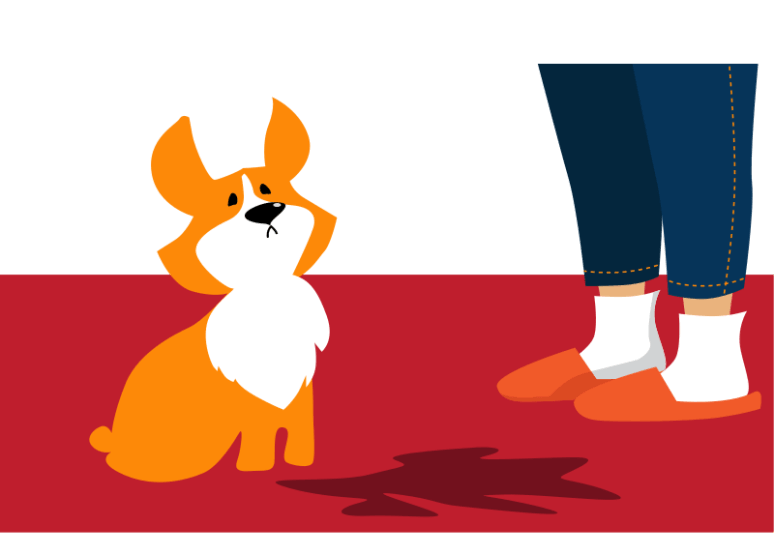
There is a time in the life of every female dog when they are ready to get pregnant. This period is known as being in heat, during which the female dog is fertile and can become pregnant.
It’s important to be able to recognize the signs that your dog is in heat, which typically occurs every six to twelve months. The following signs may indicate that your dog is in heat:
Physical Signs That a Dog Is in Heat
During the heat cycle, there are several physical changes that you may notice in your dog. These changes include:
- Swollen nipples and vulva: As your dog enters heat, you may notice that her nipples and vulva become swollen. This is because the body is preparing for a potential pregnancy by increasing blood flow to the area.
- Spotting: One of the most obvious signs that your dog is in heat is spotting, which is bloody discharge from the vulva. The discharge may be yellow, red, or brown. This discharge is a result of hormonal changes in the body and is a natural part of the reproductive process.
- Large, red, swollen vulva and nipples: During heat, your dog’s vulva may become visibly larger, redder, and swollen. This is a result of increased blood flow to the area as the body prepares for mating. It is important to note that these changes are temporary and will subside once the heat cycle is over.
It is important to keep an eye on your dog during this time as she may be more susceptible to certain health risks. Additionally, it is important to consider spaying your dog to prevent unwanted pregnancies and to avoid the potential health risks associated with repeated heat cycles.
Behavioral Signs That a Dog Is in Heat
- When a dog enters heat, there are several changes that may occur in her behavior and physical condition. Some of the most common changes include:
- Increased urination: During heat, your dog may urinate more frequently than usual. This is because the hormonal changes associated with heat can increase urine production.
- Personality changes: Your dog’s personality may change during heat. Some dogs may become more clingy and seek more attention from their owners, while others may become more irritable or aggressive.
- Nesting behavior: As your dog enters the later stages of heat, she may start to exhibit nesting behavior. This may involve digging in blankets or bedding, or trying to make a nest out of other soft materials. This behavior is normal and is a sign that your dog is preparing for the possibility of pregnancy.
- Licking of genital area: Dogs in heat may lick their genital area more than usual. This is a normal behavior that helps to keep the area clean. However, excessive licking could be a sign of an infection or other medical issue, so it is important to monitor your dog’s behavior and contact your veterinarian if you have any concerns.
- Receptive to male dogs: During heat, your dog may become more receptive to male dogs. This may involve standing still or “presenting” herself to a male dog. It is important to keep your dog on a leash and away from male dogs during this time to prevent unwanted breeding.
- Changes in tail position: Some dogs may hold their tails to one side or lift them higher than usual during heat. This can be a sign that your dog is in heat and may also indicate her receptiveness to male dogs.
- Behavior changes: Dogs in heat may exhibit a range of behavior changes, including being over-friendly to other dogs, roaming to find male dogs, mounting and humping, and becoming anxious and nesting. These behaviors are all normal and are a result of the hormonal changes that occur during heat.
It’s important to keep a close eye on your dog during heat, especially if she is not spayed. If you have any concerns or notice any unusual behavior, it’s always best to speak with your veterinarian for guidance. In addition, it is important to provide your dog with a safe and comfortable environment during this time, with plenty of soft bedding and toys to keep her occupied.
When Does a Female Dog Have Her First Heat?
The first heat cycle in a female dog can occur as early as four months of age or as late as 12 months of age, with the average first cycle occurring around six months. There are many factors that can affect the timing of the first cycle, including the dog’s breed, socialization, living environment, nutrition, and exercise.
A female dog will begin her first heat cycle once she reaches puberty. This can be a chaotic and confusing time for both you and your dog. However, if you have chosen not to spay your new puppy or if you plan to breed with her in the future, this is an unavoidable period that you will need to go through.
Let’s take a closer look at the dog’s heat cycle to help you understand your female dog’s first season and learn how to make things easier for her during this period.
The Four Stages of a Dog’s Heat Cycle
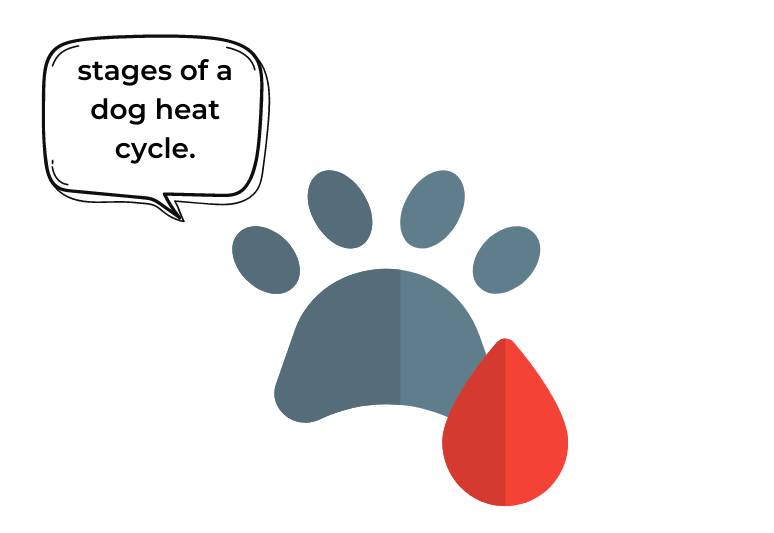
The dog’s heat cycle consists of four stages: proestrus, estrus, diestrus, and anestrus. Each stage has different signs related to physical, behavioral, hormonal, clinical, physiological, and cytologic changes.
The following is an overview of the different stages and the changes related to each stage.
1. Proestrus Stage
The proestrus stage is the first stage of the dog heat cycle, lasting between 3 and 17 days, with some dogs experiencing approximately 9 days in proestrus. The first signs of the proestrus stage in dogs are tail tucking and swelling of the vulva.
These are the best ways to detect the beginning of your dog’s heat cycle. During this stage, a male dog will be attracted to the female, but she won’t be receptive.
2. Estrus Stage
The estrus stage, which is when a female dog becomes fertile and her ovaries discharge eggs for fertilization, can last about 21 days. However, some dogs experience this stage for an average of 9 days, similar to proestrus.
A female dog will not be ready to mate until she reaches this stage. When a male approaches during this stage, the female dog will welcome the advances instead of tucking her tail.
3. Diestrus Stage
This third stage lasts for about 2 months. It is the stage where the female dog is no longer receptive to the male. If she has become pregnant, her body will continue with the pregnancy. Otherwise, her body will return to rest as her vulva goes back to its normal size and the discharge disappears.
At this stage, whether the bitch is pregnant or not, she lacks the conditions to mate and is no longer interested in flirting.
4. Anestrus Stage
Anestrus is a crucial stage in a dog’s heat cycle, lasting from 100 to 150 days, making it the longest stage of the cycle. During this period, the dog’s body goes into a resting phase, and they are infertile. Once anestrus ends, the entire heat cycle begins again, starting from the beginning.
The resting stage is a vital time for the female dog’s body to prepare itself for the next pregnancy. During this stage, the ovaries stop producing eggs, and the uterus begins to repair and rebuild its lining. The process allows the uterus to be in optimal condition for the next pregnancy, providing a healthy environment for the development of puppies.
Anestrus is also an essential time for the dog’s physical and emotional well-being. The period allows the dog’s body to rest, recover, and replenish the energy lost during the previous heat cycle. It is a time for the dog to recharge, regain strength, and prepare for the next cycle.
Moreover, during anestrus, the dog’s behavior may change. The dog may become less active, less social, and less playful. The dog may also seem more irritable or moody. These changes are a result of hormonal shifts in the dog’s body, and it is crucial to provide the dog with a comfortable and stress-free environment during this time.
In conclusion, anestrus is a critical period in a dog’s heat cycle. It is a time for the dog’s body to rest and prepare for the next cycle. It is also a time for the dog’s behavior to change, and it is essential to provide a comfortable and stress-free environment for the dog to recover and recharge.
Dog in Heat Symptoms: What Are The Signs That Your Dog Is Going Into Heat
Caring for your dog while she is in heat can be challenging. However, it is important to know when your dog is in heat to make her feel comfortable.
Knowing the symptoms can help you prepare for the experience. The following are the signs that your dog is in heat:
- The first symptom is that your dog’s vagina will start to swell, and she will start shedding blood.
- Dogs in heat will be moody, growling at humans, and may fight with other unspayed females in the house.
- They will show an increasing interest in roaming or leaving the yard to find a male dog to mate with.
- There may be an increase or decrease in interest in human interaction.
- This period comes with frequent urination.
- The dog may also change the position of her tail.
What to Do When Your Dog Is in Heat?
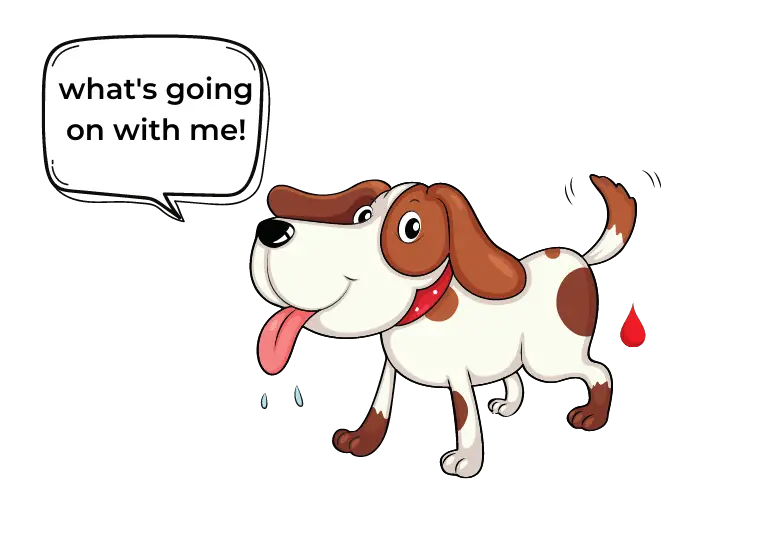
When a female dog enters her heat cycle, many dog owners approach the situation in one of two ways.
The first way is to panic without knowing what to do. The second way is to ignore the fact and treat the dog as if nothing has happened.
However, a loving and responsible dog owner learns about the situation and what they can do to help their dog stay comfortable. If your dog is going through her first heat cycle, the following tips will help you handle the situation properly.
1. Do Not Allow Your Dog to Go Out of The Yard Alone.
Protecting your female dog from male dogs and unwanted pregnancy is crucial when she is in heat, regardless of whether you plan to breed her or not. Male dogs have a strong drive to find a female in heat, and you don’t want to be caught off guard with a strange male dog tied to your dog outside.
-
3/4 ACRE OF CIRCULAR COVERAGE: The adjustable circular range allows up to 3/4-acre of coverage (22-105 feet in all directions) from the placement of the indoor transmitter~
NO WIRE TO BURY: A wireless boundary allows you to create a safe barrier around your yard to protect your pets without spending time burying wires~5 LEVELS OF CORRECTION: The system features 5 levels of static correction plus a tone-only mode~STATIC-FREE REENTRY: Allows your pet to return home without being corrected if your pet passes the boundary~STAY & PLAY COLLAR: System comes with 1 waterproof, rechargeable receiver collar that comfortably fits dogs 5 lb and up and adjusts to fit neck sizes 6-28 inches~SIMPLE SET-UP: Set up your new wireless fence in just 1-2 hours to give your dog a secure play area~PORTABLE: Take this compact, portable fence with you when you and your dog go camping or travel in your RV (outlet required). Receiver collar charges in 2-3 hours and each charge lasts 3 weeks
Prices pulled from the Amazon Product Advertising API on:
Product prices and availability are accurate as of the date/time indicated and are subject to change. Any price and availability information displayed on [relevant Amazon Site(s), as applicable] at the time of purchase will apply to the purchase of this product.
2. Never Let Your Dog off Her Leash When She Is in Heat.
Although you may consider your dog to have excellent obedience skills, no amount of obedience training can outsmart natural instincts when a dog is influenced by her hormones and is determined to find a mate. During your dog’s heat cycle, you can still take her for walks, but be sure to keep her on a leash at all times.
3. Find The Balance Between Exercise and Rest
When a female dog is in heat, she may react differently. Some may become restless, while others may feel tired throughout the day. As a responsible dog owner, monitoring your dog’s behavior and choosing the proper amount of exercise and rest is important to keep your dog comfortable.
During heat, it’s essential to provide your dog with a safe and comfortable environment. Exercise is important, but it’s crucial to find the right balance because too much exercise can make your dog feel uncomfortable and tired. On the other hand, not enough exercise can make your dog restless and anxious. Therefore, try to keep your dog active but avoid over-exerting her.
Pay attention to your dog’s body language and behavior. If your dog seems tired, take a break and let her rest. Make sure she has access to clean water and comfortable bedding. Providing toys and puzzle feeders can also keep your dog entertained and mentally stimulated, which is important during heat.
4. Pay Extra Attention to Your Dog
When your female dog is in heat, it’s essential to pay extra attention to her. Avoid any events where other dogs are involved, such as dog shows or parks, as the scent produced by a female in heat will distract the males and hamper their performance. Most male dog owners get upset if someone breaks this “rule” and shows up at a dog show with a dog in heat.
During the heat cycle, your dog may also exhibit different behaviors, such as being over-friendly to other dogs, roaming to find male dogs, mounting and humping, and becoming anxious and nesting. These behaviors are all normal and are a result of the hormonal changes that occur during heat. By paying extra attention to your dog, you can better understand her needs during this time and provide a safe and comfortable environment.
5. Use Menthol to Mask The Scent
Putting menthol on the tip of your dog’s tail is a helpful technique when walking your dog outside during heat. It is a good trick to mask the scent, and it can be useful if a male dog suddenly appears nearby, since he won’t detect your dog is in heat. However, this technique won’t work very well if he comes closer. Bathing your dog more often will help reduce the scent as well.
When using menthol, be sure to use a small amount and not to apply it directly to your dog’s skin or genitals. Menthol is a strong scent that can irritate your dog’s skin and mucous membranes. Instead, apply a small amount to a cotton ball and gently rub it on the tip of your dog’s tail.
In summary, finding the right balance between exercise and rest, paying extra attention to your dog, and using menthol to mask the scent are all helpful tips to keep your female dog comfortable during heat. By providing a safe and comfortable environment, you can help your dog navigate this natural and normal part of her life.
- 100% natural active ingredients~sHelps relieve chest aches associated with colds/s~Can be applied to chest, neck and back~sRelieves muscle aches and pains/s~Aromatic vapors soothe nasal passages
Prices pulled from the Amazon Product Advertising API on:
Product prices and availability are accurate as of the date/time indicated and are subject to change. Any price and availability information displayed on [relevant Amazon Site(s), as applicable] at the time of purchase will apply to the purchase of this product.
6. Use a GPS Tracker
During a female dog’s heat cycle, she may become restless, anxious, and more interested in roaming to find a mate. While it’s important to keep a close eye on your dog during this time, it can be challenging to monitor her every move, especially if she suddenly runs away to pursue a male dog. That’s where a GPS tracker comes in handy.
A GPS tracker is a device that you can attach to your dog’s collar, which will allow you to track her movements in real-time. With this device, you can easily and quickly find your dog if she runs away in search of a mate. This way, you can protect her from unwanted pregnancy and ensure her safety.
GPS trackers are especially useful for dogs that are not spayed and may be more prone to running away during their heat cycle. By using a GPS tracker, you can have peace of mind knowing that you can quickly locate your dog if she wanders off.
In addition to helping you find your dog, GPS trackers can also provide you with other useful information, such as your dog’s activity levels and location history. This information can be helpful in monitoring your dog’s health and ensuring that she is getting enough exercise.
Overall, using a GPS tracker during your dog’s heat cycle can be a great way to keep track of her movements and ensure her safety. With this device, you can rest assured that you will be able to quickly locate your dog if she runs away in search of a mate.
- LIVE TRACKING & LOCATION HISTORY - Follow your furry friends every step in real-time on your phone. See where your dog has been and what theyve been up to.
- VIRTUAL FENCE - Mark safe spaces, like your garden, and know the moment your dog leaves one - and when they come back safely.
- ALL-DAY ACTIVITY MONITORING - Track active time, rest and calories burned. Set fitness goals. Keep your buddy in great shape with Tractive GPS for dogs.
- SMALL, LIGHTWEIGHT & 100% WATERPROOF - Running through the forest, rolling in the mud or a dip in the lake are no problem for Tractive.
-
WORLDWIDE LOCATION TRACKING - Use your GPS tracker for dogs throughout the USA, Canada and 150 other countries. Manage all features via the free Tractive GPS app for iOS and Android or in any browser.~
SUBSCRIPTION PLAN NEEDED - Monthly, 1 year, 2 year and 5 year plans available starting at $4.99 per month.~
Prices pulled from the Amazon Product Advertising API on:
Product prices and availability are accurate as of the date/time indicated and are subject to change. Any price and availability information displayed on [relevant Amazon Site(s), as applicable] at the time of purchase will apply to the purchase of this product.
7. Consult With Your Veterinarian
Although being in heat is not an illness, it’s a good idea to talk to your vet about what to do during the heat period. This can help you be prepared for unexpected issues.
Sometimes, a female dog may experience health problems after a heat cycle if the uterine lining remains thick and produces more fluid. This creates a perfect environment for bacteria to grow, which can lead to a uterine infection.
Frequently Asked Questions About a Dog in Heat.

Conclusion

In this article, I’ve shared some information on an important topic – how to tell if a dog is in heat. Knowing this can be really helpful if you’re planning to breed your dog or get a new dog.
It’s important to remember that being in heat is a natural and normal part of a dog’s life, not a health problem. Even though it can be tough to watch your dog go through it, understanding when your dog is in heat can help you prepare for the experience.
Please make sure to take precautions to keep your dog comfortable and safe. And if you’re not planning to breed her, you can always get her spayed to avoid any problems.
Thank you for reading my article! Until next time, take care and stay safe!
You may also like…


